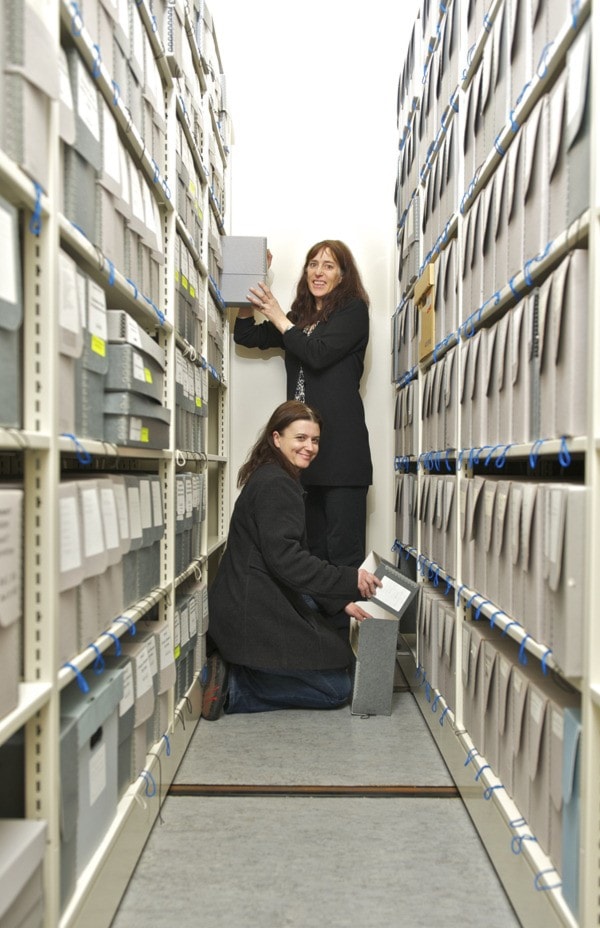It's off the beaten path, but the Delta Museum and Archive Society hopes its new community archives will draw many through its doors to learn more about the history of their hometown.
The expanded archives, celebrating its opening today, will hold both the museum's community records and the municipality's records, as part of a new partnership between the society and Corporation of Delta. The newly renovated home was made possible thanks to a combination of municipal, provincial and federal funding totaling $675,000.
To get to the archives' entrance, head to the back of the old Delta courthouse building on Clarence Taylor Crescent, neighbouring Municipal Hall.
Inside the building, immediately to your right is a new, climate-controlled storage area. The neutral colours of the room (off white walls, beige shelving units, grey floors) downplay the significance of what's on the shelves and inside the drawers and folders—a rich collection of photographs, maps, family and community histories.
Archives attendant Catharine McPherson pulls open a drawer housing microfilm reels on which old newspapers are filed. Another drawer unveils rows and rows of cassette tapes with oral histories housed in alphabetical order, labeled with names that would be familiar to longtime Deltans such as George Tamboline and Doug Husband.
Archivist Brenda Richmond says they hope to convert the tapes to DVDs, and eventually put the oral histories online as downloadable files.
The storage room's temperature and humidity is controlled to preserve the documents. Previously, the temperature was monitored and a dehumidifier brought in to control the moisture in the 1912 Tudor-style museum building where the archives were located before the move.
Richmond estimates the new storage room and its rolling shelves have space for up to five years of growth, less than anticipated, before they have to find storage off site. They are expecting 5,000 linear feet of records from the Corporation of Delta, and about 250 linear feet every year after.
Prior to Christmas all of the museum's documents had been moved on site, in part thanks to volunteers who were invaluable to the move which required plenty of pre-planning and weeks of taking inventories, packing and filing, says Richmond.
The storage area is staff-access only, but the public can conduct research and relax in the Edgar Dunning Reading Room, named after the respected newspaperman and Delta fixture who turned 100 last year and passed away in October. Shelves of books alongside two comfortable couches invite visitors to learn more about local history.
History is on the walls, too.
Above a couch in the reading room is a framed painting of the museum building in 1979 by J.R. Trevitt, who local historian Gwen Szychter says was a former busy museum volunteer with his wife. Across the room leans a framed picture of Dunning yet to be put up on the wall.
Hanging by the microfilm reader is a framed original town site map of Ladner from 1888. Szychter, who will be at the archives at least once a week researching for her new historical fiction series based in Ladner in the 1870s, says the map is incredibly valuable as a resource for locating where businesses and people were in the town site.
In addition to the extra space in the archives, simple things such as the logistics of the new space is a pleasure. Instead of traveling up and down stairs to a small room in the basement of the historical museum building, Richmond, McPherson, an assistant archivist and visitors can spread out on one level.
But with a new location comes a downside—will the public be able to find it?
The staff have a few strategies in mind for encouraging more people to use it.
The first is to make more information available online. New database software has been purchased and plans are to eventually have the public search records through the archive's website, and even buy copies of historical photographs and maps. It will be a long road to online accessibility, but key to increasing the public's awareness and use of their resources, says Richmond.
Another strategy is to focus more on Tsawwassen and North Delta to expand the Ladner-centric collection and attract more users.
Unfortunately, no longer will visitors to the museum in the heart of Ladner Village happen upon the archives. Nor will people in search of the archives pause to browse museum exhibits.
"Before when we were in the back of the museum we'd have a lot of stumblers through the door who'd maybe get interested and return, or tell their friends. It will be interesting to see how that changes," says McPherson.
"People who come here will be coming with a purpose. It will be up to us to encourage them to visit the museum and vice versa."
The Corporation of Delta is hosting an official opening of the archives today (Jan. 7), what would have been Edgar Dunning's 101st birthday. A public open house will be held Jan. 15, 1 to 3 p.m. (4450 Clarence Taylor Crescent). Regular hours are Tuesday to Saturday, 10 a.m. to 4 p.m., starting Jan. 8.
For more about the Delta Museum and Archives, visit deltamuseum.ca.
